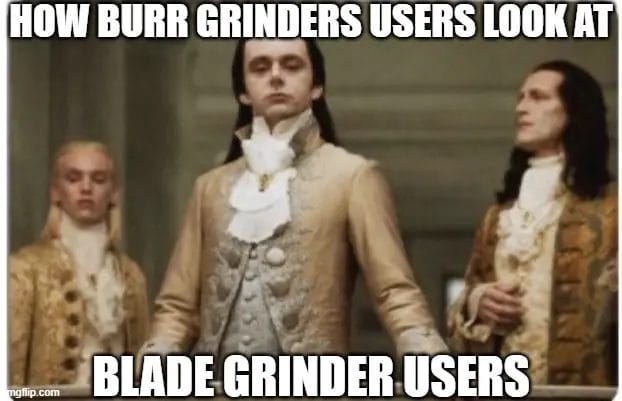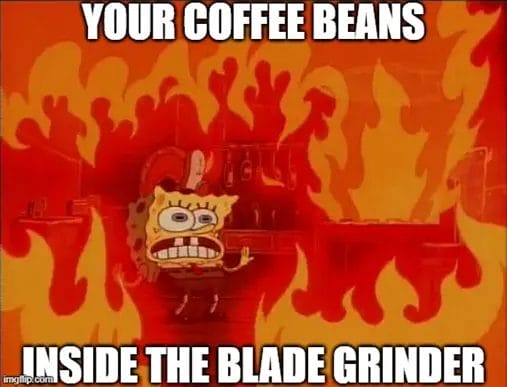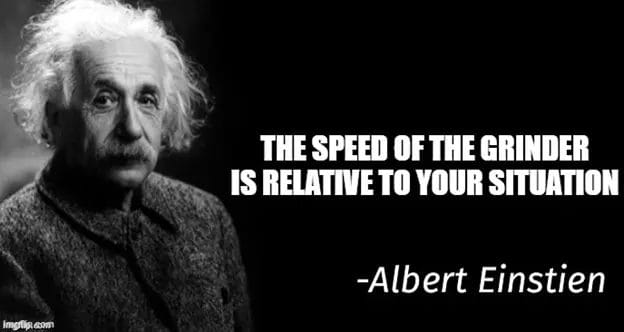Coffee grinders are friends of any coffee enthusiast who loves to brew their coffee at home. A good grinder is a must for your everyday coffee routine to ensure you have the best grind available for brewing. We know there are two types of coffee grinders available: the blade grinders and the burr grinders. But in a battle of blade grinder vs. burr grinder, which comes out on top?

Today, we look at the characteristics and differences of both blade and burr grinders to determine which one is better for your morning coffee experience.
Blade Coffee Grinder
All-electric blade grinders have the same design: A double-pronged, propeller-like blade attached to the bottom of the chamber. The sharp blade spins at a high pace and chops up anything it touches. Most blade grinders come with only one button that makes the blade spin.
When the coffee beans touch the blade, they turn into small bits of different sizes. Finer grounds hit bottom only to hit the blades and get ground again. The larger particles are almost always on the top, occasionally hitting bottom to get chopped into smaller bits.
The inconsistent grounds produced in this method are so uneven that you can even find half a bean left in the chamber when you’re done grinding.
Burr Coffee Grinder
Also known as burr mills, burr coffee grinders are dedicated grinders for coffee beans, so the design varies from traditional blade grinders.
In a standard electric burr grinder, two conical burrs (outer burr and inner burr) are set right opposite to each other and funnel the beans through the grinding area. The funneling process only allows a few beans at a time. That way, the grinder provides uniform grinds.
The burrs in the grinder are either made of ceramic or stainless steel. You can change the position of the burrs to create different grind sizes. Doing so allows you to experiment with varying grinds of coffee and brew methods.
Due to the versatility conical burr grinders offer, they are the standard go-to grinders for a vast majority in the coffee industry. Even professional grinders prefer an electric burr grinder over a blade grinder for the consistent and high-quality grind.
Which is Better: Blade Grinder vs Burr Grinder?
Now that we know about our options, let’s look at the factors that set them apart.
Factor #1: Consistency
When you consider this part, the burr grinder is a clear winner. Even when considering lower-end models, burr grinders can handle coarse grinds and provide consistent results with uniform size.
On the contrary, you can’t expect consistency even when you have a high-quality blade grinder in your hands. Sure, you can pulse and shake the grinder to ensure all the beans hit the blades, but it will never achieve the same level as a burr grinder.

The worst part is blade grinders act on complete randomness. You can grind the same batch of beans twice with two entirely different results, which provides an inconsistent grind against your will.
This issue becomes more evident when you’re trying to grind for espresso. Coffee grinds that you get from a blade grinder will never be good enough for espresso; it’ll be barely acceptable grind quality at best.
Factor #2: Coffee Flavor And Extraction
The consistency of the grinders affects the extraction rate and creates a huge difference in flavor.
An easy-to-understand example of this is a potato. When you cook potatoes in smaller sizes, they become overcooked. But a larger piece of potato needs a longer time to cook properly.
The same goes for coffee beans. When you have a different particle size of beans in the same pot, part of your coffee will get over-extracted, and part of it will remain under-extracted. In addition, if you have a finer grind size, the coffee extracts faster. In contrast, coarse grinds provide a slow extraction, creating a difference in taste.
When you over-extract your coffee grounds, it’ll taste highly bitter. On the other hand, under-extracted coffee tastes like stale water. A mix of both grinds will make your coffee an undrinkable mess that you don’t want to deal with after waking up in the morning.
Burr grinders ensure that you get consistent grind sizes every time you grind your coffee beans for a drink. So the extraction process goes smoothly, providing you with a fine cup of coffee.
Factor #3: Heat Transfer
Blade grinders heat up real fast, and low heat retention can be a big problem.
When the coffee beans are ground, the surface of the beans is more open to the air and other elements that can cause different reactions. Heat changes the properties of the coffee.
When the heat from the grinder transfers into the chamber, it has no way to get out since the chamber is sealed when grinding. Exposure to extra heat ruins the quality of your coffee grind and can take away most of the aroma and flavor. You can feel the flavor difference in your taste buds when you take a sip.

But in the case of burr grinders, the heat transfer rate is much lower, so you don’t have to worry about the heat from the grinder ruining your ground beans.
So burr grinder wins this one too.
Having fun Nomie? Check out our another battle of classic piece on single origin vs blend espresso.
Factor #4: Grind Size Customization
Different grind sizes are compatible with varying methods of brewing. So if you want to brew your coffee a certain way, you need to get the grind size just right to go along with the brew method.
For example: If you’re using an Espresso machine, you need a fine grind for a decent Espresso. In the case of a French press, you’ll need a coarse grind. But a drip coffee maker requires a medium-fine grind.
This means you need an option to customize and control your grind size if you want a more consistent experience. But that isn’t something you can achieve with a blade grinder.
As we mentioned earlier, the consistency of a blade grinder is entirely random, so you can’t expect a particular type of grind just by putting the beans in there and hoping for the best. Therefore, the grinding time is the only control you have over a blade grinder.
This is where burr grinders come in. Most burr grinders available on the market have a different grind setting for every situation. In addition, some grinders have a wide range of settings and sizes, while others allow you to move the burrs around freely for even more options. But those are expensive.
Factor #5: Durability
After a long time of use, blade grinders lose their sharpness. This can happen even faster if you regularly grind light roast beans.
Lightly roasted coffee beans are harder than usual, so they strain the blade when they hit the blade at high speed. Repeating the same process over a long duration causes the blades to dull out, and you can’t replace them unless you buy an entire grinder.
Burr grinders don’t use any form of blades, so they last longer with ease. And that’s me talking about ceramic burr grinders. If you consider a steel burr grinder made of high-end stainless steel. Better the grinder quality is, the better the durability.
So if you are looking for a sturdy burr grinder, getting the stainless steel version is your best bet.
Factor #6: Grinding Speed/Quantity

It’s true, depending on whether you are grinding beans just for yourself or a group of people. If you grind only for yourself, you will find your coffee beans go from beans to pieces in seconds. But if you are grinding for a group of people, blade grinders can be a slow and painful process.
Another issue with blade grinders is the heat. When you grind for too long on a blade grinder, the grinder heats up really fast, and it can interfere with your grinding process. Worst case scenario, you’ll have to stop the grinder for a bit to let it cool down.
With a burr grinder, it doesn’t matter how many people you grind for or how long you grind for, as the grind will always come out the same and without any interruptions.
Factor #7: Price
The only part where blade grinders have a win is the price difference. Blade grinders work with really simple mechanisms, so you can get a cheaper blade grinder for as low as $20 if you look hard enough. And this makes blade grinders the common option on top of the list of affordable grinder options.
But in the case of burr grinders, the price range is a bit high. Even if you’re looking for an entry-level burr grinder, you have to spend at least $100. A decent burr grinder can cost you around $200-$400, and a high-quality grinder can easily cross the $1000 mark.
But considering the number of advantages a burr grinder provides, it’s a worthy long-term investment.
Had fun reading our blade grinder vs burr grinder article? Check out our another piece on how to clean burr grinder.
Bottom Line
From the difference between blade and burr grinders stated above, we can clearly see that burr grinders win by a mile. Though it’s not as cost-efficient as a blade grinder, the facilities this grinder type provides are what make it worth the hefty price tag.
If you’re convinced to get yourself a burr grinder, I hope your experience is consistent, smooth, and joyful. Have fun with your freshly ground coffee.
Cheers!
FAQs
Burr grinder is better than blade grinder in more than one aspect, so burr grinder is a clear winner.
Burr grinders offer a more consistent grind than blade grinders, which is why burr grinders are better.
Blade grinders are usually operated with very simple mechanisms, lowering production costs. So blade grinders are relatively cheaper options.
Conical grinders have two conical burrs placed on the exact opposite of each other. On the other hand, a flat burr grinder has two burr rings that sit at the bottom of the grinder horizontal to the non-moving surface.
Burr grinders offer a consistent grind that you can customize according to your brewing methods. Safe to say, burr grinders help you make the best cups of coffee with a superior grind quality and uniform grind size.
The electric versions are faster and more efficient, while manual grinders require some elbow grease to make it all work. Plus, the electric grinders are more consistent than, let’s say, a manual burr grinder. So an electric grinder is a better choice than a manual burr coffee grinder.

